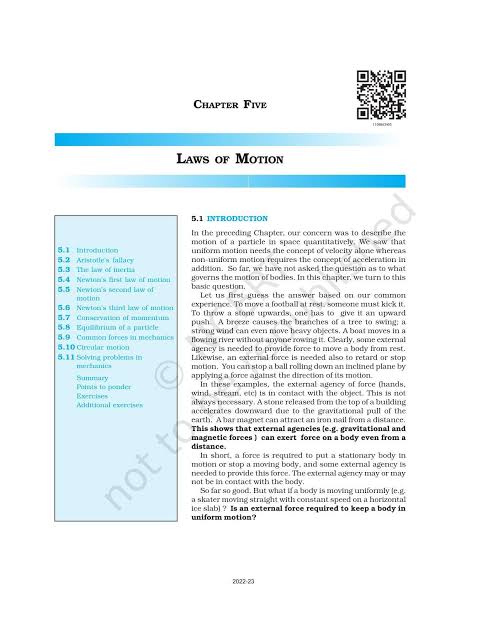
Class 12 physics chapter 5 book 📚 download
Questions and answers ❓
Question: What is Newton’s First Law of Motion?
Answer: Newton’s First Law of Motion states that an object will remain at rest or continue to move in a straight line at constant velocity unless acted upon by an external force.
Question: How does Newton’s First Law of Motion explain the concept of inertia?
Answer: Inertia is the tendency of an object to resist changes in its state of motion. Newton’s First Law explains inertia as the property that causes an object to remain at rest or to move uniformly unless influenced by an external force.
Question: What is Newton’s Second Law of Motion?
Answer: Newton’s Second Law of Motion states that the rate of change of momentum of an object is directly proportional to the applied force and occurs in the direction of the force.
Question: Explain Newton’s Third Law of Motion.
Answer: Newton’s Third Law of Motion states that for every action, there is an equal and opposite reaction. This means that forces always occur in pairs; if one object exerts a force on a second object, the second object exerts an equal and opposite force on the first object.
Question: How does Newton’s Second Law relate force and acceleration?
Answer: According to Newton’s Second Law, force is the product of mass and acceleration. This means that a larger force will result in a greater acceleration for a given mass.
Question: What is the concept of equilibrium in terms of forces?
Answer: An object is in equilibrium when the net force acting on it is zero. This means that all the forces acting on the object are balanced, resulting in no change in its state of motion.
Question: How can you describe the motion of an object with zero net force acting on it?
Answer: An object with zero net force acting on it will either remain at rest or continue to move with a constant velocity in a straight line, according to Newton’s First Law of Motion.
Question: What is meant by the term ‘momentum’?
Answer: Momentum is the product of an object’s mass and its velocity. It is a vector quantity that represents the quantity of motion an object has.
Question: What is the principle of conservation of momentum?
Answer: The principle of conservation of momentum states that the total momentum of a closed system remains constant if no external forces act on it.
Question: How does friction affect the motion of objects?
Answer: Friction is a force that opposes the relative motion of surfaces in contact. It acts in the direction opposite to the motion, thereby reducing the velocity of an object.
Question: Describe the role of a force in changing the state of motion of an object.
Answer: A force causes a change in the state of motion of an object. It can either accelerate the object, decelerate it, or change its direction of motion.
Question: What is the difference between static and kinetic friction?
Answer: Static friction acts between surfaces that are not moving relative to each other, while kinetic friction acts between surfaces in relative motion.
Question: How does Newton’s Third Law apply to the action and reaction forces in a collision?
Answer: In a collision, the action force exerted by one object on another results in an equal and opposite reaction force from the second object back to the first. This ensures that the total momentum is conserved.
Question: Explain the concept of ‘impulse’ in relation to momentum.
Answer: Impulse is the change in momentum of an object when a force is applied over a period of time. It is equal to the product of the force and the time interval during which the force acts.
Question: How does mass affect the acceleration of an object when a constant force is applied?
Answer: According to Newton’s Second Law, for a given constant force, a larger mass results in a smaller acceleration. Conversely, a smaller mass results in a larger acceleration.
Question: What is meant by ‘terminal velocity’?
Answer: Terminal velocity is the constant velocity that a falling object eventually reaches when the force of gravity is balanced by the air resistance or drag force.
Question: How do action-reaction pairs of forces influence the motion of objects?
Answer: Action-reaction pairs do not cancel each other out because they act on different objects. Each pair of forces affects the motion of the objects they act upon.
Question: What is the difference between mass and weight?
Answer: Mass is a measure of the amount of matter in an object, while weight is the force exerted on an object due to gravity. Weight depends on the mass of the object and the gravitational field strength.
Question: Explain the concept of ‘free-body diagram’.
Answer: A free-body diagram is a graphical representation used to show all the forces acting on an object. It helps in analyzing the forces and predicting the object’s motion.
Question: How does the concept of relative motion apply to objects in different frames of reference?
Answer: Relative motion refers to the calculation of the motion of an object with respect to another object or frame of reference. It helps to describe how the motion of one object appears from the viewpoint of another object or observer.
Download Chapter 5 Laws of Motion Handwritten PDF solution
👇👇👇👇👇👇
Isaac Newton’s short Biography

🍎🍎🍎🍎
Isaac Newton was a renowned English scientist and mathematician, born on January 4, 1643, in Woolsthorpe, Lincolnshire, England. He is widely recognized for his groundbreaking work in physics, mathematics, and astronomy. Newton’s most famous contribution to science is the law of universal gravitation, which he formulated after observing an apple fall from a tree, leading him to ponder the force that caused it to fall. This discovery was a key element of his work, “Philosophiæ Naturalis Principia Mathematica” (Mathematical Principles of Natural Philosophy), published in 1687, which laid the foundation for classical mechanics.
In addition to his work on gravity, Newton developed the three laws of motion, which are fundamental to understanding the behavior of objects in motion. These laws describe the relationship between a body and the forces acting upon it, and their motion in response to those forces.
Newton also made significant contributions to mathematics, including the development of calculus, independently of German mathematician Gottfried Wilhelm Leibniz. His work in optics, particularly his study of light and color, led to the invention of the reflecting telescope, which improved the observation of celestial bodies.
🍎🍎🍎😊😊
Beyond his scientific achievements, Newton was also a deeply religious man who wrote extensively on theology and alchemy. He served as the President of the Royal Society and was knighted by Queen Anne in 1705. Isaac Newton’s legacy continues to influence modern science, making him one of the most important figures in the history of science.

Get involved!
Comments